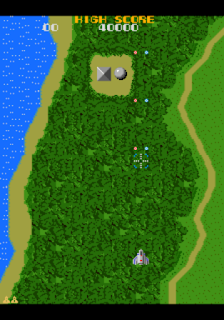I've started on the flying enemies. As a direct result, the SUB CPU transcode is 99.99% complete. There's one small AI-related routine that I'll leave until I've RE'd the logic. Otherwise, the Toroid now appears!
 |
| The first AI-driven flying objects - Toroids |
As I've mentioned before, the ground-based enemies are not affected by the adaptive AI; every enemy and even their firing frequency is fixed in the game, regardless of the DIFFICULTY dipswitch setting or how well the player is playing. It's the flying enemies that respond to these parameters.
I haven't RE'd all the AI logic just yet, but I do know roughly how the flying enemies are selected.
In addition to all the ground-based objects, the map data contains 'placeholder' objects which invoke different functions for the flying enemies. These include:
- set the number and type of flying enemies explicitly
- increment the AI level (using the DIFFICULTY dipswitch setting) and re-calculate the number and type of flying enemies
- reset the number and type of flying enemies (stops new ones appearing)
The MAIN CPU ROM contains a table of flying enemy numbers and types in order of increasing difficulty; the 2nd function above uses the AI level to index into this table.
Once those variables have been set in the SUB CPU program as the map is being generated, the MAIN CPU program loops over a function that spawns flying enemies according to the current number and enemies type setting.
Obviously I had to implement these functions in order to have the Toroids appear, but I will note that I wasn't sure how/when those variables were being cleared. And when I was debugging the spawning, I actually couldn't find where they were being cleared - this meant that the routine was spawning flying enemies every single invocation - once every VBLANK!?!
So I went back to the arcade code and found exactly the same behaviour! And then it finally dawned on me... the number of flying enemies represents the number AT ANY ONE TIME, not the total number! So for example, 3 Toroids actually means 3 Toroids on-screen, and as soon as one is destroyed or leaves the screen, another one is spawned! FTR spawning an object that already exists has no effect.
I should have realised that a lot sooner, as there are a lot more Toroids than the handful that appear in the map data at the start of Area 1, for example. But I haven't been focusing on flying enemies for quite a number of weeks now.
Now that I understand this, I can proceed with transcoding more flying enemies.
FUN FACT: On the EASY dipswitch setting, the AI level increment used in the above function is set to 0. However it is actually incremented elsewhere, so it does get a little harder.
UPDATE: Toroid, Jara and (1 type of) Zoshi now complete. After some debugging, I'm confident now that the AI is levelling up correctly, as I see the same sequence and number of flying enemies as on the original. I'll have to ramp up the difficulty to HARDEST now to get all the enemies to appear sooner.
In the process I also did some miscellaneous code tidy-up - including the elimination of some duplicated inline code - and added the missing messages at the start of each Solvalou!
 |
| Didn't realise these messages were missing! |
The MAIN program is around 5,000 lines now. If I'm using the metric that the 68K code is round 1/2 the number of lines of the Z80 code (~11,000 lines) it means I'm getting close to the end now. Aside from finishing off a handful of flying enemy object handlers, there's the destruction of said enemies (common routine), destruction of the Solvalou, and some miscellaneous housekeeping like zeroing variables, updating high scores, awarding bonuses based on score etc. And that's about it, except for sound!
UPDATE #2: I've been flying through the flying enemies and they're all transcoded now except for the Bacura (spinning mirrors) as they are handled in their own routine. There are a few minor bugs but they shouldn't be too difficult to fix. I will need a way of injecting specific enemies into the game at a certain point; that's what build options are for! I also need to document the behaviour of the different variants of certain enemies (Zoshi, Zakato, etc).
I've also done a little bit more of the AI RE in the process; I now know it keeps track of the number of Solvalou you have used in the game, and does some calculation with your score; I'm betting it's working out your average points per Solvalou - but yet to RE any further.


































